Text
To-Be-Looked-At-Ness & Blindness
Dark romance has been a genre of interest for mainly the younger generation. This genre almost always has scenes where the men/man are gazing at the woman. She is always the main focus and these kinds of films emphasize the “to-be-looked-at-ness” as well.

According to Linda Williams, “Like the female spectator, the female protagonist often fails to look, to return the gaze of the male who desires her” (Williams, 17). Since society has been fixated on a man’s gaze towards a woman, it has affected the way we view films. From the very beginning of film, this industry has implemented this male gaze and now it is something that we will almost always see in every film we watch. The man will always be staring at the woman while she does not pay attention to his gaze, but we as viewers are usually in the man’s perspective. We are always seeing the way he views her, the close up angles of the woman’s body, and the slow tilt starting from the bottom of her feet to the top. These kinds of camera angles are shown in thousands of films like Jennifer’s Body, The Virgin Suicides, Transformers (all of the transformers movies), Twilight, and many more.
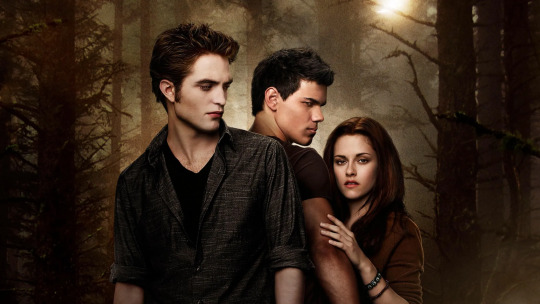
Williams also talks about how there is this kind of “blindness” in the female characters that we see on screen that allows men to look at them. “Blindness in this context signifies a perfect absence of desire, allowing the look of the male protagonist to regard the woman at the requisite safe distance necessary to the voyeur’s pleasure, with no danger that she will return that look and in so doing express desires of her own” (Williams, 17-18). Women in films are depicted as “blind” and are usually oblivious at the fact that a man is gazing at her. They do this to entice the male audience, making her somehow more attractive or mysterious, by not reciprocating back the same gaze and desire he is demonstrating towards her.
0 notes
Text
Depiction of Girlhood in Films
Independent films usually present the truth behind certain topics that are unheard of or taboo to mention, especially in other countries. These films demonstrate the struggles and difficulties that people endure, mainly within their cultural background or by traditions that were passed down onto future generations.
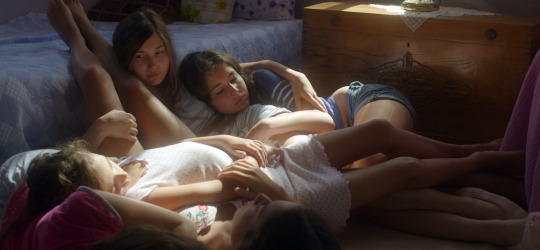
A film that comes to mind that was not discussed in this class but in my middle eastern cinema course, was a Turkish film, Mustang by Deniz Gamze Ergüven, which was released in 2015. This film has been compared to Sofia Coppola’s The Virgin Suicides (1999) because Mustang depicts five orphan girls who are controlled by their conservative family, forcing them into arranged marriages and practically destroying their freedom.
Sherry Ortner’s theories regarding independent filmmaking in her book, Against Hollywood: American independent film as a critical cultural movement, talks about how smaller films that are produced on their own, are offering this truth and bringing awareness to things that have been and are currently happening in real time, but through film. “Many independent films embrace a kind of hard realism, making films that display the dark realities in contemporary life, and that make demands on the viewer to viscerally experience and some to grips with those realities.” Mustang perfectly demonstrates this visual experience of what young girls go through and how their girlhood is stripped away from them. Ergüven and Coppola’s films depict these troubling moments of women at a young age and without their creative works, we wouldn’t have seen or been able to empathize with them.
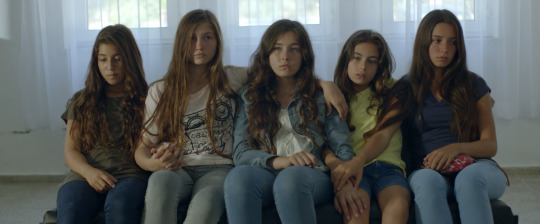
They both have unique characteristics to their films that make them stand out and by addressing these problems, it makes us viewers have a different perspective towards these conservative families. Independent films emphasize not just the importance of how young women are treated in other countries, but they open up a new world to filmmakers, inspiring them to continue creating pieces that can help change and influence younger generations.
1 note
·
View note
Text
Gender Fluidity in Media
Gender identity has continued to be a topic of discussion for the last few years. People have raised the question, what exactly is “gender identity” and how does it correlate specifically with the film industry?
Judith Butler, a gender studies writer and philosopher talks about this certain topic within her book, Gender Trouble: Feminism and the Subversion of Identity. It dives deep into how or why stereotypes are created and an analytical discussion about these identities regarding gender fluidity as well. In the book, it states that, “The heterosexualization of desire requires and institutes the production of discrete and asymmetrical oppositions between ‘feminine’ and ‘masculine,’ where these are understood as expressive attributes of ‘male’ and ‘female’”(Butler, 23). In this quote, it expresses how there are these particular characteristics and appearances of what society determines someone as male or female due to the social norms that were and still are shown through the media. Butler is saying that there is no particular fixed attribute that labels what a person’s gender is. Gender is fluid and that people can express their identities however they want, but it can be difficult to demonstrate that when there are people in this world who do not agree with this fluidity.

I feel that in recent years, the fluidity of gender has been expressed more and accepted within society. The kinds of stereotypes that supposedly determine between a “male” or “female” have been changing throughout recent forms of media, which is comforting to see. For example, the Netflix series, Sex Education has a few characters that are gender fluid and or within the LGBT+ community and the HBO series, Euphoria presents characters who are also gender fluid/non-binary. Not only is this shown through shows, but also through other forms of art like comic books, specifically the character Loki, the God of Mischief from Marvel.
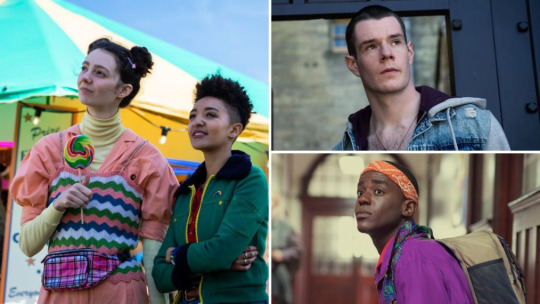
Gender fluidity has become more welcomed and accepted within the media, which helps normalize it within society. It’s very refreshing to see the media and film industry gradually changing, appreciating, and becoming more inclusive with this community by making them feel noticed and heard because it was difficult for this to be shown or discussed in the past.
0 notes
Text
How Does She Look?
Bigelow has definitely opened up a bigger pathway for women in film as the first woman to receive an academy award for best director in 2010. Two more female directors have also won an academy award for best director as well, in 2021 (Chloe Zhao, Nomadland) and in 2022 (Jane Campion, The Power of the Dog). I believe that this is just the start of women gaining more recognition for their work and that we will be seeing more women receive praise for their efforts in the near future.
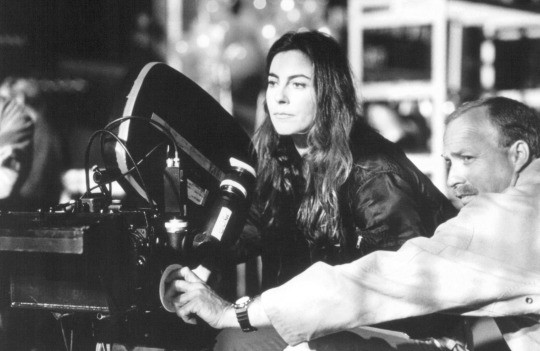
In the reading, How does she look?: Bigelow’s vision/visioning Bigelow, by Deborah Jermyn stated, “ Bigelow’s visibility has come precisely because she has adopted a mode of ‘muscular filmmaking’, in which Bigelow’s visibility has come precisely because she ‘masquerades as a hyper-macho bad boy to win the respect of a male-dominated industry,’” (Jermyn, 2021). As a woman, I feel a little conflicted with this statement because I understand how difficult it may be to receive that approval towards the public that is very male dominated, but I think it is saddening to hear that in order to be ‘accepted’ into this industry, we must produce films that are more appealing for men. Meaning that we have to create films that men will like or have an interest in or else women will have it harder to receive that recognition if we created something that was more feminine. It’s the sad truth that society has accepted at this point, but I believe that things will and are changing.

Jermyn also talks about Bigelow’s physical appearance that I find intriguing and somewhat empowering because for her Vogue interview photoshoot before the 2010 Oscars, she said, “No make-up, let’s get it over with… no lip gloss and no stylist; I’m happy with a jacket and jeans,” (Jermyn 2021). I find it very inspiring to see Bigelow comfortable in her own clothes, not trying to fit in by wearing anything flashy or looking more feminine in this photoshoot. I think that this influences all women to feel comfortable in whatever they’re wearing and that we should be true to ourselves and to the public as well.
0 notes
Text
The Male Gaze
In the film, Clueless by Amy Heckerling, there were multiple scenes that involved the “Male Gaze” theory which was created by Laura Mulvey. This specific image that is shown above demonstrates the stereotypes that are constantly shown throughout films of how women are “supposed” to dress and how men act or behave around women who show more revealing clothing. This “gaze” that men portray is quite disgusting and disturbing. The fact that these are continuously depicted, especially in films that are set in high schools, is appalling. These are supposed to be high school students that should be putting all their focus and time on their education, not worrying about how good they should look or what make up they need to put on to gain a man’s attention. It is saddening to see numerous shows and films that create stories where women feel the need to get the guy, mostly through their appearance.

A passage from Laura Mulvey’s, Visual Pleasure and Narrative Cinema states, “In their traditional exhibitionist role women are simultaneously looked at and displayed, with their appearance coded for strong visual and erotic impact so that they can be said to connote to-be-looked-at-ness” (837). This concept of “to-be-looked-at-ness” is strongly implied in this scene of Clueless, and it is disappointing to see that we as a society continue to accept that it is okay to demonstrate a man’s interest in a way where his admiration for the woman is objectified.
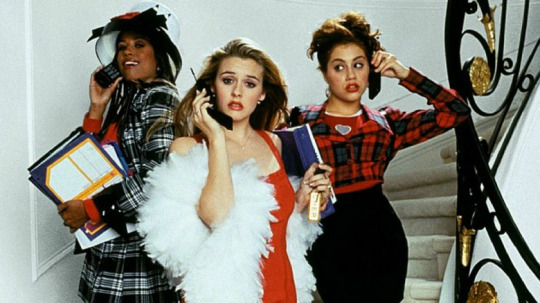
It is upsetting to me that even the younger generation is catching on to focusing their appearance even more because of social media and by the entertainment that we create in this industry. The fact that these films are set in high school and are targeted towards children and the generation below us is quite concerning because we are continuing to accept that the “male gaze” is something that will or must happen to us, even at a young age.
0 notes
Text
Pleasure, Fear, and Pain

“In each of these genres the bodies of women figured on the screen have functioned traditionally as the primary embodiments of pleasure, fear, and pain,” (Williams, 1991). Women’s bodies in all genres of film tend to be sexualized and are usually catered towards men. People can see it both ways as empowering for women to be expressing their bodies in films, but at the same time, it can be degrading and create a different perspective or open more judgements towards them.
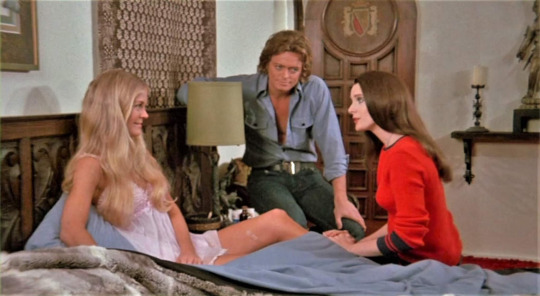
In the film, The Velvet Vampire, by Stephanie Rothman, released in 1971, she plays around with this topic while also bringing awareness to the unfairness that women deal with in society regarding pleasure and a woman’s needs. Since this world is more in favor of men, women are supposed to always please the man and the men tend to ignore what a woman wants. For example, the men are usually meant to finish when having a sexual encounter and when they want something, they may beg the other person for it, but if that person does not want to go through with it, they begin to feel guilty because they know the men are “supposed” to receive and finish.
I think it’s interesting because in this film, Rothman creates a visually poetic and compelling story that brings up these topics of women giving, and not receiving any of their needs, their pleasures, or their wants. Tying back to Williams’ theories, women's bodies are practically objectified and used only for a mans’ pleasure, which is demonstrated here within The Velvet Vampire. Not only does this film talk about issues that were common at that time, but it relates to even the present.
0 notes
Text
Masculinity in Film Noir

“Gays function as both villains and frustrations of the heterosexual development, as do the femme fatales. This in fact seems to be central to film noir,” (Dyer, 1977). The very first film noir that was directed by a woman was in 1953 by Ida Lupino. She created The Hitch-Hiker, which surprises people that a woman made this, because of how this film does not incorporate the stereotypes that are typically shown in noir regarding women. People like to assume that if a woman is producing or creating a film, they expect it to be more “feminine” or less “masculine” to attract more of the female audience, especially when it comes to film noir. Richard Dyer stated that film noir is mainly focused on femme fatales and that they usually have dark lipstick, very pale skin, they are blonde, and present the stereotypical physical features that is more respected or acceptable in women at that time.
Because of the pressure to create something feminine as a woman in film, I believe that Lupino wanted to focus on masculinity within men and the weird obsessions that people have for men who are criminals. People still have a fascination for them even though they have done something bad, which is interesting because I think they are intrigued by this “bad boy,” and watching shows that have something to do with crime to experience this “high” or this “erotic pleasure” through film, since we do not experience it in our own lives.
This is why Lupino wanted to focus on the men in this film and change the way film noir is presented to the film industry.
1 note
·
View note
Text
It Depends on the Filmmaker, Not the Camera

“Cameras do not make films; filmmakers make films,” (Maya Deren, 1965). Maya Deren talks about how it does not matter what camera you use when it comes to filmmaking. It depends on the filmmaker and their creative process, not the quality of the video production. Many people believe that you must have the most expensive camera to produce a film, but there are various directors and filmmakers that have made films on a low budget that have had a significant impact on our perspective towards the world of film.
One filmmaker that comes to mind that was mentioned above is Maya Deren. Her debut film that she acted in was, The Meshes of the Afternoon, which was released in 1943 on a $275 budget. Her unique experimental film was unlike anything that was seen before at this time. It was so original and new that it is appreciated even decades later.
In Deren’s film, she uses many mirrors as a way to symbolize how the main character is searching for her identity and when she sees different versions of herself or “clones,” it represents how we may have various personalities around others, especially around men. People have different perspectives on how they view us, so I believe that Deren is trying to show us that, while also touching up on how women are trying to escape a “man’s world.” This dreamlike illusive imagery that is presented to us creates this surreal environment that is up for our interpretation. This was something that was not common at the time, which is why Deren was such an influential filmmaker.
0 notes
Text
Women & the Cinemafication of the World

In class for week 3, we talked about how back in the day, at the very beginning of film, film was made by and for women. Even in the readings that were assigned to us, “Women and the Cinemafication of the World,” Not So Silent: Women in Cinema Before Sound, by Jane M. Gaines talks about how the world of film at the early stages was for women, not men. The reading also talked about how even though men have so much power over us women, we are able to get ahead with the use of our bodies, but in a positive way.
In the film, Dance, Girl, Dance, by Dorothy Arzner that was released in 1940, touches on these topics of how women were able to progress their careers and their work by their bodies, but they did this in a way to demonstrate how empowering and degrading it can be for women. Society has degraded women for decades, making it demeaning and not acceptable for our bodies to be “used” to get us places, which is shown through Arzner’s work. Not only does she show the difficulties and advantages that we may have when we use our bodies, but she also illustrates how the film industry is changing because of men, making it harder for women to have a career in this field.
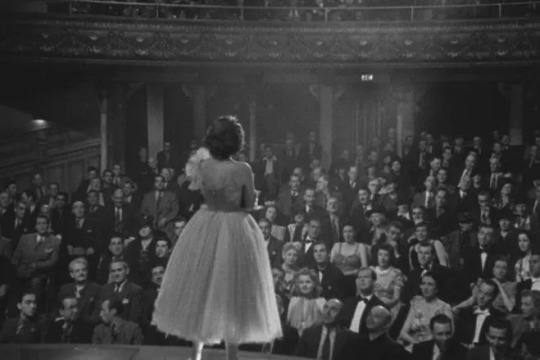
A specific scene that correlates to this would be towards the end, where the audience, which was mostly full of men, yells at Judy and boo her because she wasn’t performing provocatively like Bubbles. When Judy cannot deal with it anymore, she yells back at them, telling them how she knows that they all want her to just remove her clothes for their enjoyment and entertainment. They weren’t there to appreciate her performance, they only wanted to fulfill their lustfulness and watch her like an animal in a zoo. Not only was Judy yelling at the audience in the film, but she was also calling out the people watching and how disrespectful everyone is to treat her or any woman like that, especially in this industry.
Women have it so difficult to be seen and treated with respect and it’s disappointing to see how things are still stuck in the past. By creating these films and speaking out about these issues help bring more attention to things that need to change.
0 notes
Text
What it Means to Be a Woman
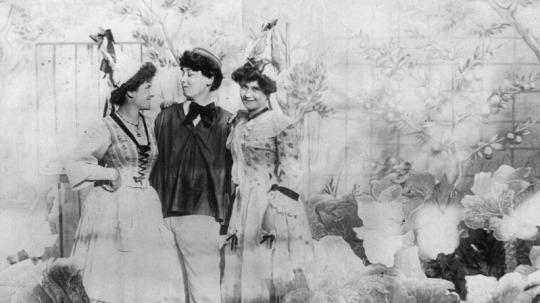
Alice Guy-Blache, who is considered the first female director in the world, is one of the pioneers for women in the film industry to create and direct films that were conceptual, but unique at the time. One of her films that we watched in class was titled, Midwife to the Upper Class, which was released in 1902. It was almost like a sequel or extended version of her other short film, The Cabbage Fairy (1896). Midwife to the Upper Class was a silent, black and white short film that depicted a fairytale-like universe where a woman seems to be selling baby dolls. A couple discusses what they want to do and they end up looking through all the different babies in a garden that is filled with cabbages. The couple decides which baby they want while the woman selling the babies picks up each one to show them, but puts them back down when the couple shakes their heads. The woman also shows a colored baby doll with black skin, which I thought was interesting, but the couple disregarded the doll until they found a real baby to adopt.
I thought this film was very unique because of the set design and the plot at the time. Guy had a woman working behind the stand, showing how independent she was (which was not common), while also showing another woman, the wife, how she had the choice to pick her own child. The man wasn’t deciding for her, he was only helping pay for his wife, which is another issue that was depicted, of how women have to get their finances from the man in the family.
This ties into one of the readings that we were assigned to read for class, “What It Means to Be a Woman: Theorizing Feminist Film History Beyond the Essentialism/Constructionism Divide,” Not So Silent: Women in Cinema Before Sound (2010), by Monica Dall’Asta. She talks about how women in films were usually absent because of the “inabilities” and that the stereotypes made it harder for women to be respected. Because of this division between genders, it has made it difficult, not just for female actors, but especially for female directors to receive any recognition for their work, which is why Guy is an important/influential woman to be changing those stereotypes with her work, by bringing awareness to these gender issues.
0 notes